Products
Used
I
wanted to try many different energy efficient and
green building materials. As a believer that these
practices should be mainstream, I used standard
products such as from big box stores whenever
possible such as no formaldehyde insulation, zero
VOC adhesives and paint, energy efficient exterior
doors, and 1.6 gallon flush toilets. Other products
were purchased from companies specializing in
ecofriendly products such as the low VOC
polyurethane product.
Photovoltaic
System:
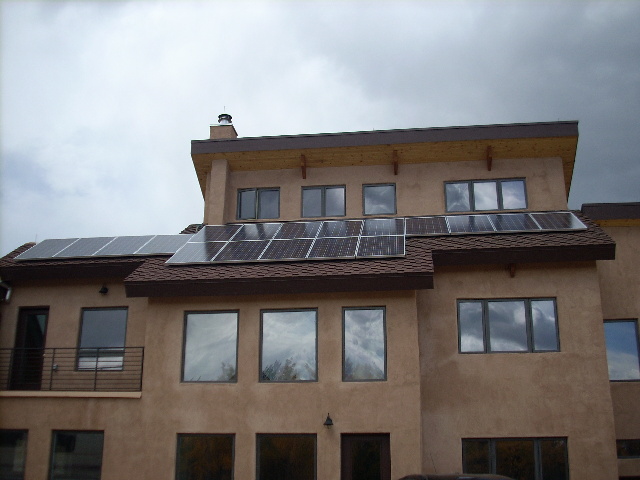
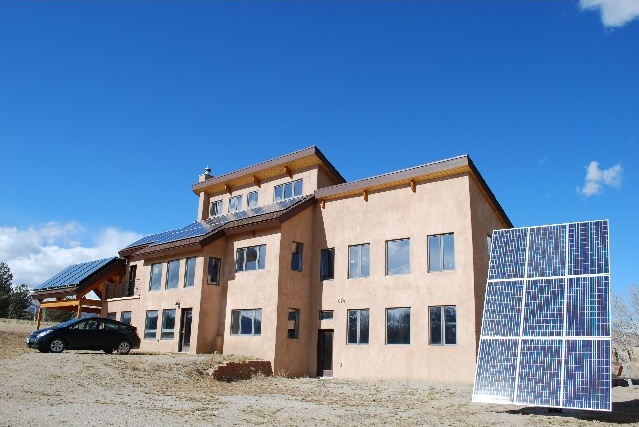
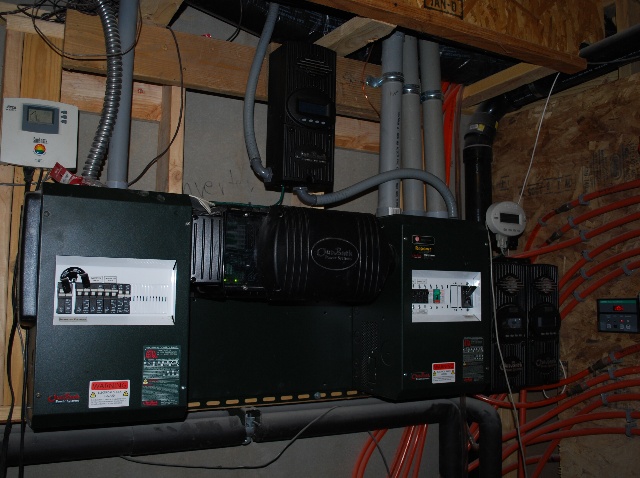
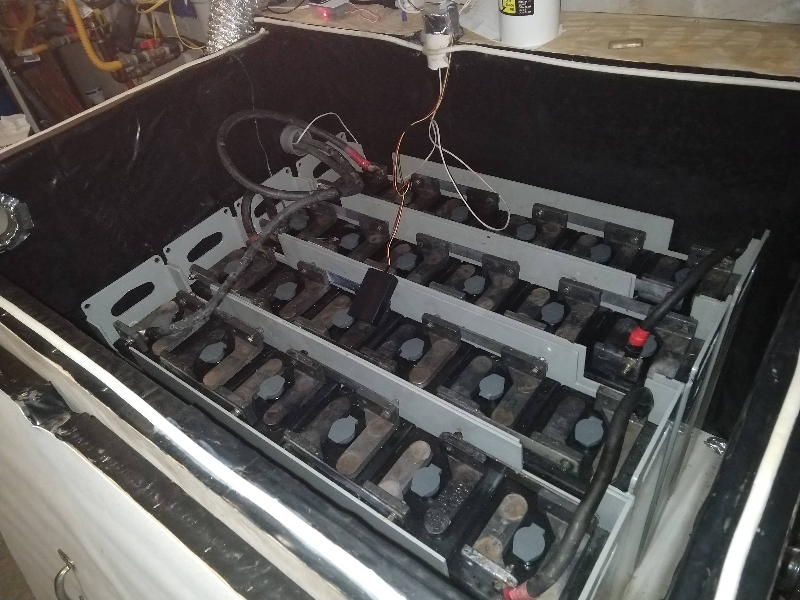
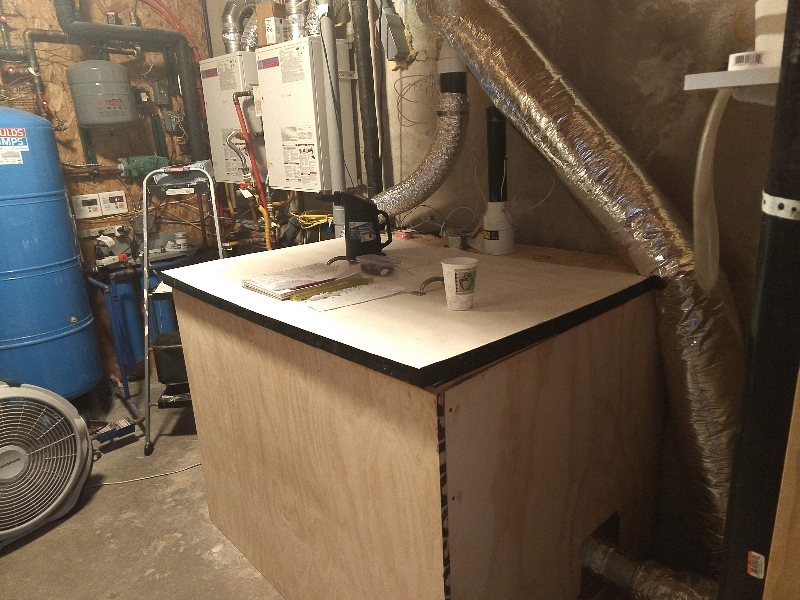
We
have a 5.6 KW photovoltaic system which is off the
grid. It uses 27 Sharp
208 panels (18 roof top and 9 ground mount). Originally we had
2 Outback
MX60's and 1 FLEXmax
60 Maximum Power Point Tracking (MPPT)
Charge Controllers as well as an Outback VFX3648 inverter in a
Ready Watt Half Rack Power Center. On 12/17/24 we replaced the aging Outback Equipment with a Sol-Ark 12-2P-N and are very happy with the performance.
I chose roof
mounting so that our lightening protection system
would cover the panels, however I can push snow off of only
about 1/2 of the panels from the roof-top deck. The
fixed pitch of the panels is that of the roof (33
degrees) which is less than ideal for our latitude
but more importantly not steep enough for snow to
fall off rapidly. The snow can stay on the roof
mount panels for several days. We therefore
installed the pole mount at a 65 degree angle to
shed the snow in the winter.
The battery bank is 48V flooded lead acid. We went through 3 sets
of Trojan
L16P batteries (16 then 8 then 8 batteries)
having multiple mishaps. In April of 2018, I
installed Solar
One HUP Batteries, a much larger and longer
lasting flooded lead acid battery bank (845 AmpHrs,
40 KWattHrs).
I was eligible for an off the grid
rebate from XCEL Energy until October of 2006 and
most of the original system was installed (15 of 18
panels) by that time. I received a $7800 Solar
Rewards Renewable Energy Credit rebate from XCEL
Energy.I also qualified for a $2000 2006 federal
residential energy credit. The system performs well
and has occasionally gotten more than rated wattage
thanks to the high altitude (9600 feet).
Solar
Hot Water:
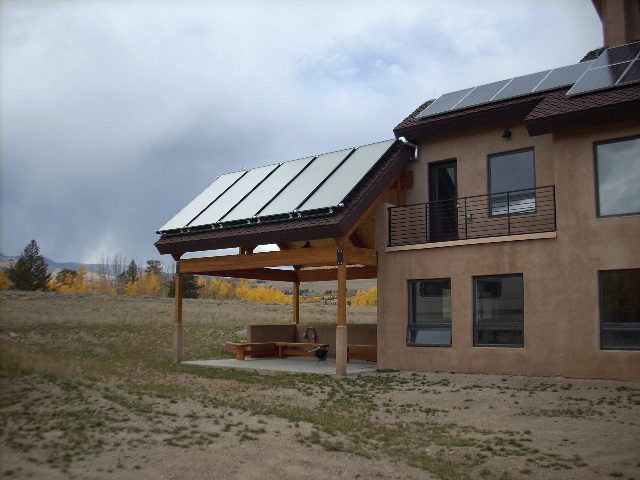
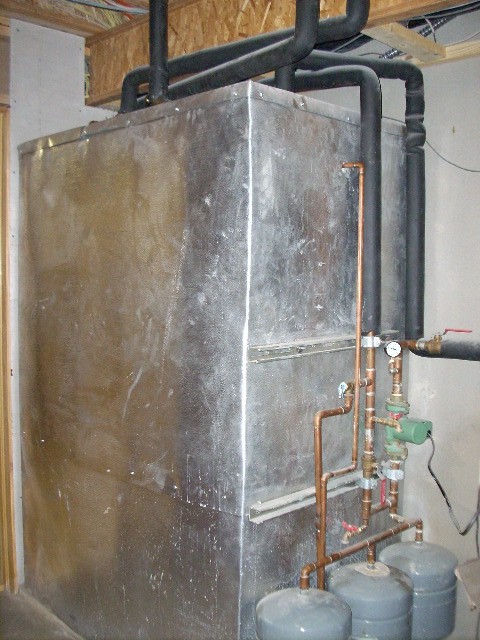

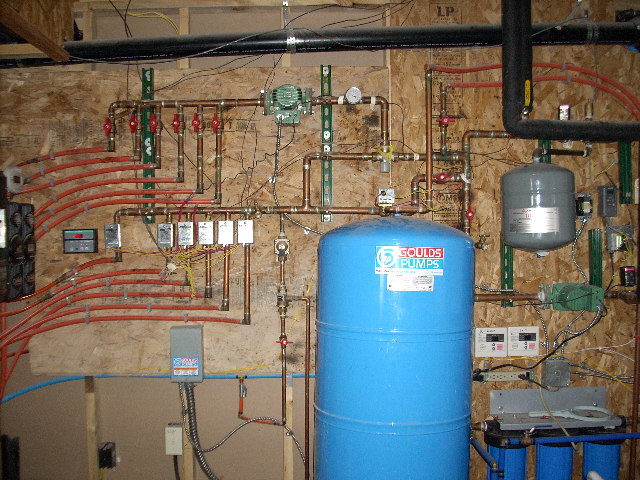
Again
wanting to roof mount panels, I installed the
maximum amount of square footage of solar hot
water panels (200 sq feet in 5 10' x 4' panels) on
the covered porch which has a greater pitch than
the rest of the house (40 degrees). We have a 380
gallon storage tank which has a maximum
temperature of 170 degrees F. This provides
essentially all of the domestic hot water and some
of the space heating with radiant in floor heat.
The solar hot water system was installed by
Industrial Solar Technology (became Novan Solar),
Golden, CO. No major problems with the solar hot water system but one of the pressure tanks needed to be replaced and new glycol is added every 10 years. There are 2 Takagi
T-DK20 on demand propane hot water heaters.
One is for domestic hot water and uses preheated
water passing through the storage tank. If the
heater is off or the temperature of the water is
above the setpoint, the heater will not turn on.
The radiant infloor heat uses the preheated water
passing through the storage tank until it falls
below a setpoint and then switches over to water
heated by the Takagi. The solar hot water system
qualified for a $2000 2006 federal residential
energy credit.
Thermal
Mass: The passive solar gain relies on
thermal mass including exterior and interior walls
of 6" concrete slab (these are plastered but not
covered by inside insulation, 4" floor concrete
slab, and slate tile floors. The masonry fireplace
and the laminated pine deck floor in the loft also
add some mass. This thermal mass leaves the
temperature of the house relatively stable.
Without heat in the winter, the temperature drops
about 4 degrees F overnight.
Insulation:
The house is well insulated with 4 inches of foam
on the exterior of the concrete slabs (R20) and 2
inches of foam below the slab, 12" structural
insulated panels on the roof (R42), and energy
efficient doors and garage doors. The exterior
doors are Therma-tru smooth-star fiberglass with a
solid polyruethane foam core (R13.6 for solid
doors-less with glass). The garage doors are
Overhead Door 494 (R17.5).
Windows:
Windows use "heat mirror" technology
were made by Alpen Windows, Boulder, Colorado now
called Alpen
High Performance Products,
Louisville, Colorado. The frames are fiberglass
which is energy efficient and the glass is air
filled. East and South windows are HM-88. North
and West windows are TC-88.
Renewable
products: The cabinets in the
bathrooms, kitchen, laundry and offices were made
out of lyptus which is a renewable wood. The
cabinet manufacturer Custom Cupboards from outside
of Pueblo, CO earned environmental stewardship
certification. The floors in the kitchen, laundry
room, powder room, master closet and toilet area
are engineered bamboo floating floors. The use of
carpet was limited to maximize the thermal mass
effect of the floors and to facilitate heat
transfer from the radiant infloor heat (slate over
concrete). A wool blend with jute back was used.
The underlayments used under the carpet and bamboo
floor have a low R value for heat transfer from
the radiant infloor heat. Recycled rubber tiles
were used on the decks and the room over the
garage.
 Lyptus
cabinets and bamboo flooring.
Lyptus
cabinets and bamboo flooring.
 Recycled
rubber tile on roof deck. Recycled
rubber tile on roof deck.
Appliances:
Energy star appliances were used including the
refrigerator, washing machine and dishwasher. See
my comments regarding appliance
selection.
Masonry
fireplace:
 
A Tulikivi masonry fireplace
was installed between the kitchen and the dining
room. This soapstone fireplace is fired up once or
twice a day and radiates heat all day. It is rated
to heat 1500 square feet. The open floor plan
allows this to heat up most of the house.
Air
quality : The passive ventilation of
the house works very well with low living/dining
room windows and clerestory windows at 3rd floor
level. A Standex ERV300DC was installed but was
not well planned and really only adequately
ventilates the 2nd floor. It draws about 95 watts
so it uses quite a bit of electricity with 24/7
operation. The home is very tight and is in a high
risk area for radon so the initial radon level was
very high at 38.7 pCi/L. Use of the ERV alone
resulted in a radon level of 37.9 pCi/L. I caulked
between the concrete walls and concrete slab and
used RadonSeal Deep-Penetrating Concrete Sealer on
the concrete slab floors without much improvement.
I used a very good radon mitigator, Accredited
Radon Reduction Techniques, who was patient with
my experimentation and had many good suggestions.
See description radon
mitigation. I found that DC fans gave best
performance per watt and fortunately found RAM/GAM
Engineering Services, a supplier of radon
mitigation fans in the Denver area. They used Ebmpapst
R1G175 series motors and mounted them in a
fan housing. I use RAM/GAM's 24VDC fan and had
them mount a 12VDC Ebmpapst R1G175 motor in a fan
housing for direct use with a spare solar panel
Low
VOC products: No particle board was
used in construction, cabinets or furniture.
Plywood used was exterior grade which outgasses
less than interior grade plywood. Sherwood
Williams Zero VOC paint was used as well as
low/zero VOC adhesives. Timber-Tek Crystal
Urethane (VOC 168 gms/liter) was used on tongue
and groove pine on ceilings and loft floor, doors,
and mouldings.
Energy
efficient products: At this point all of the original CFL's were switched to the more efficient LED lighting.
Energy star fans throughout the house. Energy star
computers and monitors.
Energy
saving electrical devices and home automation: Power
strips/outlet switchs to eliminate phantom amps.
Motion sensors for lights. Automatic turning on HRV and charger power only when battery voltage high enough. Optional automatic control of radiant infloor heater and battery box fan based on relevant temperature.
|

